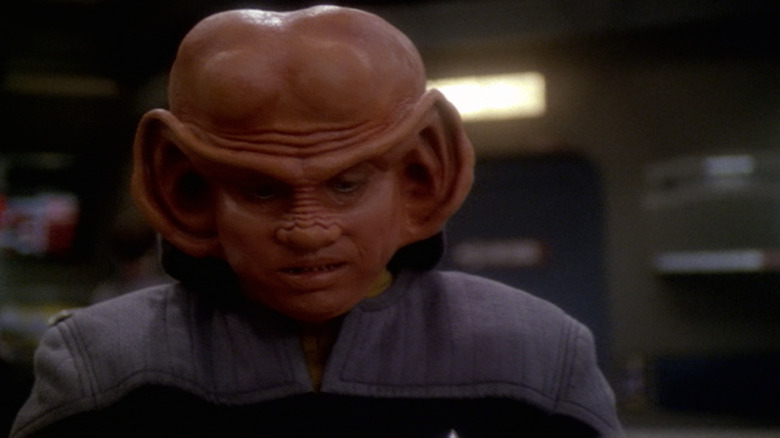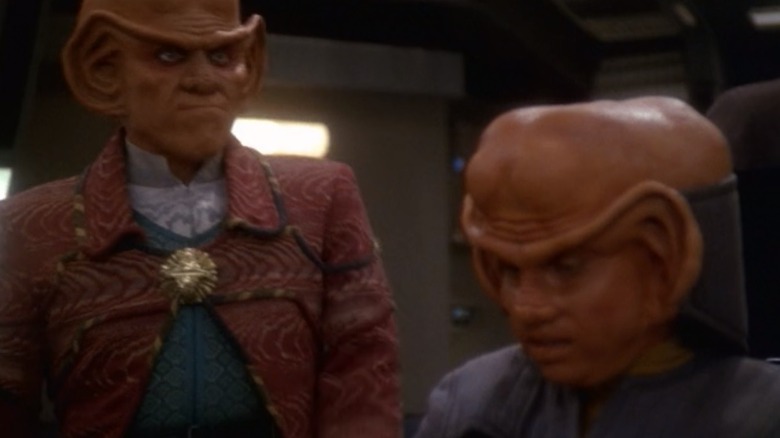Nog's Amputation In Star Trek: Deep Space Nine Could Have Been Much More Violent
In the "Star Trek: Deep Space Nine" episode "The Siege of AR-558," the U.S.S. Defiant is dispatched to a remote outpost where Federation soldiers have captured a Dominion communications relay. This was deep into the seasons-long Dominion War story ark, and "Deep Space Nine" was becoming increasingly bleak. When the Defiant arrives, they find that over 100 Federation soldiers have been killed in trying to keep the array out of the hands of encroaching enemies.
Ensign Nog (Aron Eisenberg) is part of the Defiant's team, and he has never seen combat before. The phaser fire and landmine explosions terrify him, and Nog ends up losing a leg in the battle. In "Star Trek," medical science is advanced enough to grow new legs without any issue, but Nog's sudden limb loss was horrifying. Two episodes later, in "It's Only a Paper Moon," Nog was back on Deep Space Nine, recovering with his new leg. His shell shock was so strong, however, that he moved onto the station's holosuite, content to remain in a holographic recreation of 1960s Las Vegas for the rest of his life. Nog didn't have an easy time of it.
It seems that the attack that took Nog's leg in "Assault" was originally envisioned as being a lot more bloody. According to a 2015 interview with "Deep Space Nine" co-creator Rick Berman, showrunner Ira Steven Behr planned to blow off both of Nog's legs. It also sounds as if Nog might have stayed legless for an extended period. That certainly would have hammered home the episode's traumatic themes, but Berman felt it went a little too far.
Two missing legs? I'll give you one.
Berman recalls having to compromise with Behr over Nog's injuries. Two legs blown off by a landmine was too violent, but Berman figured that one leg was less violent. He said:
"When Nog was going to have both his legs blown off, I found that a little bit too violent. There was a lot of disagreement in that and we ended up having the bizarre compromise of having him lose one leg and then getting a prosthetic leg as opposed to losing two legs, which, in retrospect is very funny."
It seems that Bermn and Behr butted heads a lot on "Deep Space Nine." Berman mentions his distaste for Behr's idea that the Federation should go to war late in the series. Berman, carrying Gene Roddenberry's optimism, felt that "Star Trek" shouldn't ever be about war. When Behr pitched the Dominion War idea, Berman initially assumed it would be over and done with after, say, six episodes. The Dominion War would ultimately cover the show's last two seasons. "Deep Space Nine" became dark and violent in a way that wasn't fun.
One might sense that "Deep Space Nine" succeeded well because of the head-butting between Behr and Berman. The former likely wanted to go hog-wild with violence and intrigue, while the latter was careful to keep the show bound in by years of established "Star Trek" mythology; Berman, after all, served as executive producer on "Star Trek: The Next Generation" as well. "Deep Space Nine," he acknowledged, was a very, very different show.
Nog ended up leaving the holosuite, finally able to face his trauma. It didn't matter if his new leg was just like the old one. The pain remained. That's good sci-fi writing.

